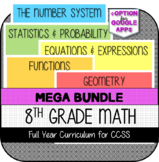Scatter Plots MINI-BUNDLE
- Zip
- Google Apps™

What educators are saying
Products in this Bundle (4)
Also included in
- NOTE: Google Apps Options - Only the ASSESSMENTS have Google Apps options. This unit is NOT ideal for "Distance Learning" unless you have special access to PDF editors that remove answer keys, etc.This resource was developed to meet the requirements of the 8th Grade Statistics & Probability StanPrice $10.00Original Price $14.50Save $4.50
- Does your state have additional standards that are not included in this resource? Email me at tptmathcafe@gmail.com for supplemental resourcesNOTE: Google Apps Options - Only the ASSESSMENTS and a few other specified activities have Google Apps options. This curriculum is NOT ideal for "Distance LeaPrice $175.00Original Price $272.99Save $97.99
Description
NOTE: Google Apps Options - Only the ASSESSMENTS have Google Apps options. This bundle is NOT ideal for "Distance Learning" unless you have special access to PDF editors that remove answer keys, etc.
This resource was developed to meet the requirements of the 8th Grade Statistics & Probability Standards below:
CCSS.MATH.CONTENT.8.SP.A.1
Construct and interpret scatter plots for bivariate measurement data to investigate patterns of association between two quantities. Describe patterns such as clustering, outliers, positive or negative association, linear association, and nonlinear association.
CCSS.MATH.CONTENT.8.SP.A.2
Know that straight lines are widely used to model relationships between two quantitative variables. For scatter plots that suggest a linear association, informally fit a straight line, and informally assess the model fit by judging the closeness of the data points to the line.
CCSS.MATH.CONTENT.8.SP.A.3
Use the equation of a linear model to solve problems in the context of bivariate measurement data, interpreting the slope and intercept. For example, in a linear model for a biology experiment, interpret a slope of 1.5 cm/hr as meaning that an additional hour of sunlight each day is associated with an additional 1.5 cm in mature plant height.
It contains:
1) Notes with Practice Problems
2) Activities (Constructing Scatter Plots & Matching Line of Best Fit)
3) Test Practice
4) Quiz
5) Answer Keys
LICENSING TERMS: This purchase includes a license for one teacher only for personal use in their classroom. Licenses are non-transferable, meaning they can not be passed from one teacher to another. No part of this resource is to be shared with colleagues or used by an entire grade level, school, or district without purchasing the proper number of licenses.
COPYRIGHT TERMS: This resource may not be uploaded to the internet in any form, including classroom/personal websites or network drives, unless the site is password protected and can only be accessed by students.




